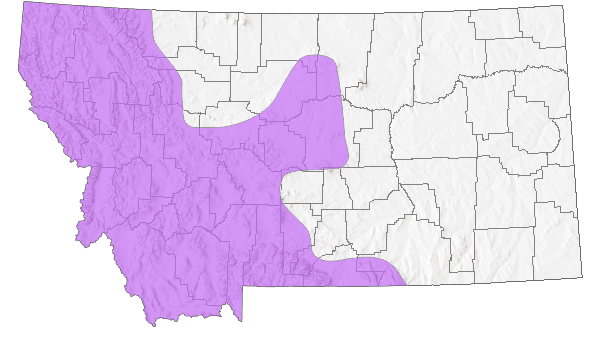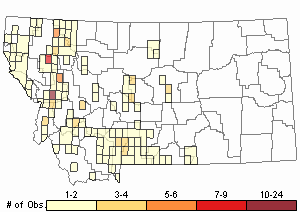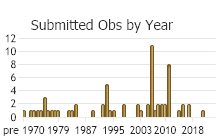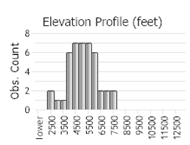View in other NatureServe Network Field Guides
NatureServe
Montana
Utah
Wyoming
Idaho
Wisconsin
British Columbia
South Carolina
Yukon
California
New York
Western Water Shrew - Sorex navigator
Native Species
Global Rank:
G5
State Rank:
S4
(see State Rank Reason below)
Agency Status
USFWS:
USFS:
BLM:
External Links
State Rank Reason (see State Rank above)
Species is apparently secure and not at risk of extirpation or facing significant threats in all or most of its range.
- Details on Status Ranking and Review
Western Water Shrew (Sorex navigator) Conservation Status Review
Review Date = 05/03/2018
Range Extent
ScoreF - 20,000-200,000 km squared (about 8,000-80,000 square miles)
Comment167,339 square Kilometers from Natural Heritage Program range maps
Long-term Trend
ScoreE - Relatively Stable (±25% change)
CommentForested stream habitat is unlikely to have declined more than 25% since European arrival
Short-term Trend
ScoreU - Unknown. Short-term trend in population, range, area occupied, and number and condition of occurrences unknown.
CommentNo data
Threats
ScoreH - Unthreatened. Threats if any, when considered in comparison with natural fluctuation and change, are minimal or very localized, not leading to significant loss or degradation of populations or area even over a few decades’ time. (Severity, scope, and/or immediacy of threat considered Insignificant.)
CommentNo threats are active at this time
Intrinsic Vulnerability
ScoreC - Not Intrinsically Vulnerable. Species matures quickly, reproduces frequently, and/or has high fecundity such that populations recover quickly (< 5 years or 2 generations) from decreases in abundance; or species has high dispersal capability such that extirpated populations soon become reestablished through natural recolonization (unaided by humans).
CommentHigh fecundity and low age of maturation
Environmental Specificity
ScoreA - Very Narrow. Specialist. Specific habitat(s), substrate(s), food type(s), hosts, breeding/nonbreeding microhabitats, or other abiotic and/or biotic factor(s) are used or required by the Element in the area of interest, with these habitat(s) and/or other requirements furthermore being scarce within the generalized range of the species within the area of interest, and, the population (or the number of breeding attempts) expected to decline significantly if any of these key requirements become unavailable.
CommentFound only in association with Montane streams
Raw Conservation Status Score
Score
3.5 + 0 (geographic distribution) + -0.5 (environmental specificity) + 0 (long-term trend) + 1 (threats) = 4
General Description
A large, semiaquatic, blackish-gray shrew with a long bicolored tail and large hind feet fringed with short stiff hairs. Total length is 14 to 16 cm (5.5 to 6.3 inches) including a 6 to 8 cm (2.4 to 3.1 inch) tail. The dense fur is glossy blackish gray above and paler or silvery beneath. Middle toes of hind feet (18 to 20 mm) are partially webbed. For good descriptions and illustrations see Burt and Grossenheider (1976), Godin (1977), Hall (1981), Beneski and Stinson (1987), Clark and Stromberg (1987), and Merritt and Matinko (1987). The sexes are similar in size and color. Sexually active males (February to September) have prominent dermal glands on each side between fore and hind legs. They show in S. p. navigator as an 8-mm oval patch of white hair (Conaway 1952). Immatures are similar in color to adults. The skull is large and heavy for a shrew, generally more than 19.5 mm long in S. p. punctulatus. The first two unicuspid teeth are noticeably larger than the next two (Banfield 1974), the third unicuspid is smaller than the fourth (Godin 1977), and the fifth is greatly reduced (Pagels 1986). For comparative illustrations of shrew dentition, see Conaway (1952), Banfield (1974), Churchfield (1990). The teeth of North American shrews show some reddish brown pigmentation. Scats of Western Water Shrews are quite distinctive, black and granular in structure, being full of remains of invertebrate exoskeletons. They are often deposited in middens on the banks of streams, in surface burrows, at burrow entrances, in the lee of rocks at the stream edge, or even sometimes quite prominently on the tops of stones (Churchfield 1990). Western Water Shrew hairs are roughly H-shape in cross section, with inner surfaces deeply ridged (see illustration in Churchfield 1990).
Western Water Shrew was previously known as the Northern Water Shrew (S. palustris), but recent analysis of genetic differences across this species range provided evidence that the species should be split into three species with the Western Water Shrew occuring in Montana.
Diagnostic Characteristics
Stiff hairs along the sides of the hind feet are found only in the Western Water Shrew and the Pacific Water Shrew (Sorex bendirii). The latter, a Pacific Northwest species, differs in being slightly larger (8.9 to 9.7 cm, 3.5 to 3.8 inches, body length) and dark brown rather than blackish-gray (Burt and Grossenheider 1976). See Carraway (1995) for a key to western North American soricids based primarily on dentaries.
Species Range
Montana Range
Range Descriptions

 Native
Native
Observations in Montana Natural Heritage Program Database
Number of Observations: 197
(Click on the following maps and charts to see full sized version)
Map Help and Descriptions
Relative Density

Recency



 (Observations spanning multiple months or years are excluded from time charts)
(Observations spanning multiple months or years are excluded from time charts)
Migration
Non-migratory.
Habitat
In streamside habitat in coniferous forests, particularly in or under overhanging banks or crevices; prefer good cover (Conaway 1952). However, also found in seasonal streams and small seeps (Kinsella 1967). Also above timberline (Hoffmann and Pattie 1968).
Ecological Systems Associated with this Species
- Details on Creation and Suggested Uses and Limitations
How Associations Were Made
We associated the use and habitat quality (common or occasional) of each of the 82 ecological systems mapped in Montana for
vertebrate animal species that regularly breed, overwinter, or migrate through the state by:
- Using personal observations and reviewing literature that summarize the breeding, overwintering, or migratory habitat requirements of each species (Dobkin 1992, Hart et al. 1998, Hutto and Young 1999, Maxell 2000, Foresman 2012, Adams 2003, and Werner et al. 2004);
- Evaluating structural characteristics and distribution of each ecological system relative to the species' range and habitat requirements;
- Examining the observation records for each species in the state-wide point observation database associated with each ecological system;
- Calculating the percentage of observations associated with each ecological system relative to the percent of Montana covered by each ecological system to get a measure of "observations versus availability of habitat".
Species that breed in Montana were only evaluated for breeding habitat use, species that only overwinter in Montana were only evaluated for overwintering habitat use, and species that only migrate through Montana were only evaluated for migratory habitat use.
In general, species were listed as associated with an ecological system if structural characteristics of used habitat documented in the literature were present in the ecological system or large numbers of point observations were associated with the ecological system.
However, species were not listed as associated with an ecological system if there was no support in the literature for use of structural characteristics in an ecological system,
even if point observations were associated with that system.
Common versus occasional association with an ecological system was assigned based on the degree to which the structural characteristics of an ecological system matched the preferred structural habitat characteristics for each species as represented in scientific literature.
The percentage of observations associated with each ecological system relative to the percent of Montana covered by each ecological system was also used to guide assignment of common versus occasional association.
If you have any questions or comments on species associations with ecological systems, please contact the Montana Natural Heritage Program's Senior Zoologist.
Suggested Uses and Limitations
Species associations with ecological systems should be used to generate potential lists of species that may occupy broader landscapes for the purposes of landscape-level planning.
These potential lists of species should not be used in place of documented occurrences of species (this information can be requested at:
mtnhp.org/requests) or systematic surveys for species and evaluations of habitat at a local site level by trained biologists.
Users of this information should be aware that the land cover data used to generate species associations is based on imagery from the late 1990s and early 2000s and was only intended to be used at broader landscape scales.
Land cover mapping accuracy is particularly problematic when the systems occur as small patches or where the land cover types have been altered over the past decade.
Thus, particular caution should be used when using the associations in assessments of smaller areas (e.g., evaluations of public land survey sections).
Finally, although a species may be associated with a particular ecological system within its known geographic range, portions of that ecological system may occur outside of the species' known geographic range.
Literature Cited
- Adams, R.A. 2003. Bats of the Rocky Mountain West; natural history, ecology, and conservation. Boulder, CO: University Press of Colorado. 289 p.
- Dobkin, D. S. 1992. Neotropical migrant land birds in the Northern Rockies and Great Plains. USDA Forest Service, Northern Region. Publication No. R1-93-34. Missoula, MT.
- Foresman, K.R. 2012. Mammals of Montana. Second edition. Mountain Press Publishing, Missoula, Montana. 429 pp.
- Hart, M.M., W.A. Williams, P.C. Thornton, K.P. McLaughlin, C.M. Tobalske, B.A. Maxell, D.P. Hendricks, C.R. Peterson, and R.L. Redmond. 1998. Montana atlas of terrestrial vertebrates. Montana Cooperative Wildlife Research Unit, University of Montana, Missoula, MT. 1302 p.
- Hutto, R.L. and J.S. Young. 1999. Habitat relationships of landbirds in the Northern Region, USDA Forest Service, Rocky Mountain Research Station RMRS-GTR-32. 72 p.
- Maxell, B.A. 2000. Management of Montana's amphibians: a review of factors that may present a risk to population viability and accounts on the identification, distribution, taxonomy, habitat use, natural history, and the status and conservation of individual species. Report to U.S. Forest Service Region 1. Missoula, MT: Wildlife Biology Program, University of Montana. 161 p.
- Werner, J.K., B.A. Maxell, P. Hendricks, and D. Flath. 2004. Amphibians and reptiles of Montana. Missoula, MT: Mountain Press Publishing Company. 262 p.
- Commonly Associated with these Ecological Systems
Alpine Systems
Forest and Woodland Systems
Grassland Systems
Shrubland, Steppe and Savanna Systems
Wetland and Riparian Systems
- Occasionally Associated with these Ecological Systems
Forest and Woodland Systems
Human Land Use
Recently Disturbed or Modified
Shrubland, Steppe and Savanna Systems
Food Habits
Aquatic insect larvae, also some vegetable matter, Oligochaetes, other shrews, arachnids, and small fish (Conaway 1952). Captures in small seeps (Kinsella 1967) imply dietary flexibility.
Ecology
A captive specimen required cold water. Used smell and tactile senses to capture fish. Fur would become soaked within several minutes immersion, and specimen dried itself by working fur with hind feet (Conaway 1952).
Reproductive Characteristics
Males produce sperm December to August. Pregnant or lactating females found February to August. Several litters/season, around 6 young/litter. Males reproductively mature 2nd year, females 1st year but often do not produce litter until 2nd year.
Stewardship Responsibility
References
- Literature Cited AboveLegend:
 View Online Publication
View Online Publication Banfield, A.W.F. 1974. The mammals of Canada. University of Toronto Press for National Museum of Natural Science and the National Museums of Canada, 438 pp.
Banfield, A.W.F. 1974. The mammals of Canada. University of Toronto Press for National Museum of Natural Science and the National Museums of Canada, 438 pp. Beneski, J.T. and D.W. Stinson. 1987. Sorex palustris. American Society of Mammalogists, Lawrence, KS. Mammalian Species No. 296:1-6.
Beneski, J.T. and D.W. Stinson. 1987. Sorex palustris. American Society of Mammalogists, Lawrence, KS. Mammalian Species No. 296:1-6. Burt, W.H. and R.P. Grossenheider. 1976. A field guide to the mammals. Third edition. Houghton Mifflin Co., Boston. 289 pp.
Burt, W.H. and R.P. Grossenheider. 1976. A field guide to the mammals. Third edition. Houghton Mifflin Co., Boston. 289 pp. Carraway, L.N. 1995. A key to recent Soricidae of the western United States and Canada based primarily on dentaries. Occasional Papers of the Natural History Museum, University of Kansas (175):1-49.
Carraway, L.N. 1995. A key to recent Soricidae of the western United States and Canada based primarily on dentaries. Occasional Papers of the Natural History Museum, University of Kansas (175):1-49. Churchfield, S. 1990. The natural history of shrews. Cornell University Press, Ithaca, NY. 178 pp.
Churchfield, S. 1990. The natural history of shrews. Cornell University Press, Ithaca, NY. 178 pp. Clark, S.G. and M.R. Stromberg. 1987. Mammals in Wyoming. University of Kansas Museum of Natural History, Public Education Series Number 10. xii + 314 pp.
Clark, S.G. and M.R. Stromberg. 1987. Mammals in Wyoming. University of Kansas Museum of Natural History, Public Education Series Number 10. xii + 314 pp. Conaway, C.H. 1952. Life history of the water shrew (Sorex palustris navigator). American Midland Naturalist 48:219-248.
Conaway, C.H. 1952. Life history of the water shrew (Sorex palustris navigator). American Midland Naturalist 48:219-248. Godin, A.J. 1977. Wild mammals of New England. Johns Hopkins University Press, Baltimore. 304 pp.
Godin, A.J. 1977. Wild mammals of New England. Johns Hopkins University Press, Baltimore. 304 pp. Hall, E.R. 1981. The mammals of North America, volumes I and II. John Wiley & Sons, New York, NY. 1181 pp.
Hall, E.R. 1981. The mammals of North America, volumes I and II. John Wiley & Sons, New York, NY. 1181 pp. Hoffmann, R.S. and D.L. Pattie. 1968. A guide to Montana mammals: identification, habitat, distribution, and abundance. Missoula, MT: University of Montana. 133 p.
Hoffmann, R.S. and D.L. Pattie. 1968. A guide to Montana mammals: identification, habitat, distribution, and abundance. Missoula, MT: University of Montana. 133 p. Kinsella, J.M. 1967. Unusual habitat of the water shrew in western Montana. J. Mammal. 48(3):475-477.
Kinsella, J.M. 1967. Unusual habitat of the water shrew in western Montana. J. Mammal. 48(3):475-477. Merritt, J.F. and R.A. Matinko. 1987. Guide to the mammals of Pennsylvania. University of Pittsburgh, Pittsburgh, PA.
Merritt, J.F. and R.A. Matinko. 1987. Guide to the mammals of Pennsylvania. University of Pittsburgh, Pittsburgh, PA. Pagels, J.F. 1986. Key to the Soricidae of Virginia. Unpublished.
Pagels, J.F. 1986. Key to the Soricidae of Virginia. Unpublished.
- Additional ReferencesLegend:
 View Online Publication
View Online Publication
Do you know of a citation we're missing?
- Web Search Engines for Articles on "Western Water Shrew"
- Additional Sources of Information Related to "Mammals"





